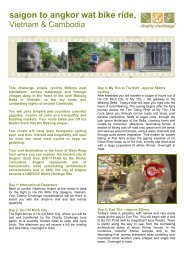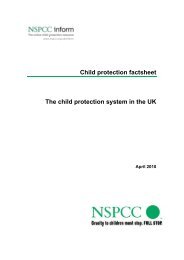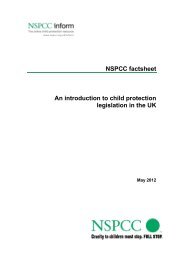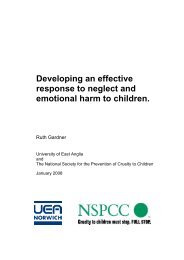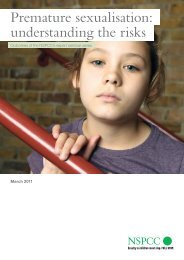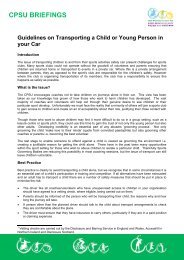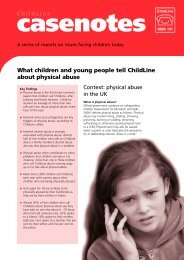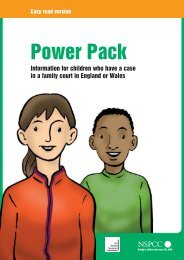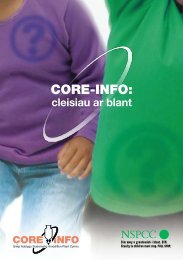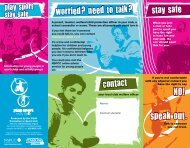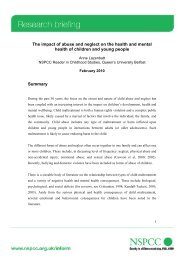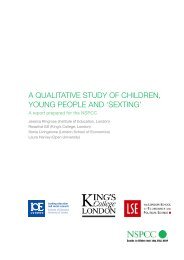Neglect and serious case reviews (PDF, 735KB) - nspcc
Neglect and serious case reviews (PDF, 735KB) - nspcc
Neglect and serious case reviews (PDF, 735KB) - nspcc
You also want an ePaper? Increase the reach of your titles
YUMPU automatically turns print PDFs into web optimized ePapers that Google loves.
uising <strong>and</strong> rough h<strong>and</strong>ling<br />
An underst<strong>and</strong>ing of child development is also important in interpreting the significance<br />
of any bruising in children living with neglect who may be known to have less than<br />
optimum supervision. These children are sometimes believed to bruise themselves<br />
more often, but any bruise needs to be carefully considered <strong>and</strong> explained in relation<br />
to the child’s age <strong>and</strong> developmental capability. A bruise also needs to be considered<br />
in relation to the parent’s capacity to supervise in a way that is appropriate to the<br />
child’s developmental needs. These issues are considered in more depth in our recent<br />
small scale study of child development <strong>and</strong> <strong>serious</strong> <strong>case</strong> <strong>reviews</strong> (Br<strong>and</strong>on et al 2011,<br />
2012). Any bruising on a pre-mobile baby has to be considered suspicious as prior to<br />
around six months babies have very limited control of their own movements. Older<br />
babies are more able to bruise themselves through falls <strong>and</strong> tumbles but where there are<br />
pre-existing concerns about neglect <strong>and</strong> emotional development, for example faltering<br />
growth <strong>and</strong> failure to thrive, workers are right to be worried about bruising, especially<br />
facial bruising which needs specialist assessment by a paediatrician rather than a GP.<br />
In some of these <strong>case</strong>s professionals had noted insensitive ‘rough h<strong>and</strong>ling’ of babies,<br />
<strong>and</strong> parents being verbally aggressive <strong>and</strong> smacking a toddler, <strong>and</strong> other inappropriate<br />
behaviours that imply physical aggression. In some families this rough h<strong>and</strong>ling was<br />
frequent behaviour <strong>and</strong> formed part of the child’s everyday experience, while in others<br />
it occurred in the build up to an incident of domestic violence or when the parent was<br />
experiencing a bout of poor mental health.<br />
professional confusion <strong>and</strong> downgrading of harm<br />
In some of these <strong>case</strong>s the risks of physical harm alongside neglect had been acknowledged<br />
to some degree, but professionals did not act with any urgency <strong>and</strong> were sometimes<br />
said to be ‘going through the motions’ in carrying out an assessment or child<br />
protection enquiry. In these <strong>case</strong>s there tended to be a gradual dilution <strong>and</strong> forgetting of<br />
concerns about the risk of physical harm which would be overtaken by a ‘this is only<br />
neglect’ mindset. This would mean that re-arranging missed appointments or ensuring a<br />
proper medical examination of a child would no longer be seen as urgent as a sense of<br />
urgency did not fit with this neglect mindset. The danger here is perhaps that in categorising<br />
children as experiencing neglect (or any single form of harm) less attention is paid<br />
to the other risks they face. In particular, neglect does not preclude physical abuse.<br />
3.7 Suicide amoNg youNg people<br />
3. A thematic analysis of neglect<br />
When the child at the centre of a <strong>serious</strong> <strong>case</strong> review is an older young person he or she<br />
will have carried with them the legacy of early experiences of care <strong>and</strong> nurture. These<br />
experiences lay the foundation of their capacity to cope with or to fail to withst<strong>and</strong> the<br />
stresses that come from outside influences <strong>and</strong> internal pressures. A number of UK<br />
researchers have increased our awareness of the vulnerability of older young people who<br />
have lived with maltreatment <strong>and</strong> how easy it is to regard them as resilient, primarily<br />
69



